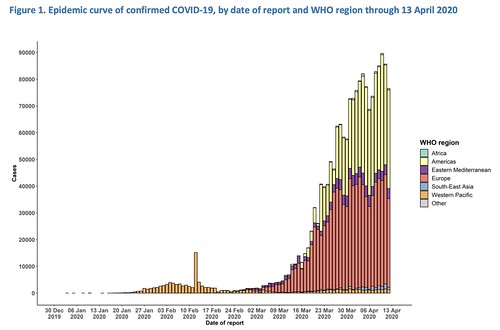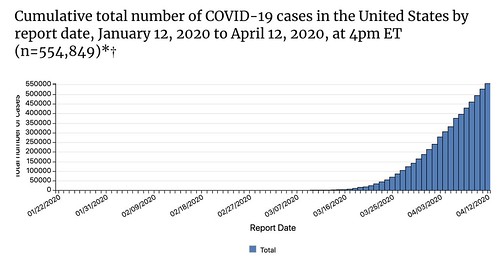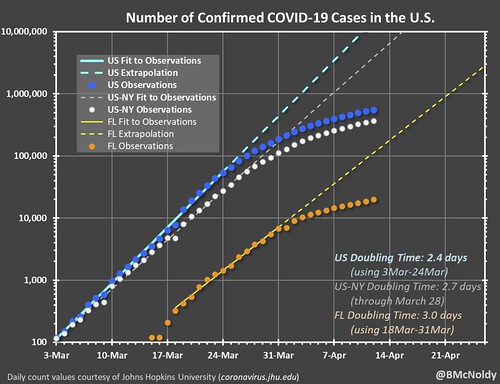Now that the severe weather has ended, I wanted to get back to updating everyone on the Coronavirus. During the past few days – since my last update – the numbers have climbed quite a bit. That isn’t surprising given that the growth rate is still along an exponential curve. Thankfully, it looks like Social Distancing tactics are working in a lot of places. Sadly, though, there are still new cases occurring, new hospitalizations reported, and more deaths.
I know we all want this to end as soon as possible. So we have to stick to our guns and keep Social Distancing for now. Keep washing those hands, and avoid touching your face.
Latest Numbers
WHO Numbers
Total Worldwide Cases: 1,773,084
Total Worldwide Deaths: 111,652
CDC Numbers
Total United States cases: 554,849
— Travel-related: 6,515
— Close contact: 8,203
— Under investigation: 534.993
Total deaths: 21,942
States reporting cases: 50 states, District of Columbia, Puerto Rico, Guam, the Northern Mariana Islands, and the U.S. Virgin Islands
COVID-19 cases reported by other medical sites:
Johns Hopkins
Total Worldwide Cases: 1,920,918
Total Worldwide Deaths: 119,686
Total Worldwide Recovered: 453,145
Total US cases: 582,580
Total US deaths: 23,621
Total US recovered: 44,278
Brian McNoldy, Senior Research Associate at Univ. of Miami’s Rosenstiel School, put a chart together of the growth. As it notes, it is pulling numbers from the Johns Hopkins totals.
Regional Numbers
| Cases | Tested | Deaths | %-positive | Mortality Rate | |
| MS | 2942 | 37733 | 98 | 7.80% | 3.33% |
| LA | 21016 | 102502 | 884 | 20.50% | 4.21% |
| AL | 3803 | 28486 | 103 | 13.35% | 2.71% |
| TN | 5610 | 76195 | 109 | 7.36% | 1.94% |
| AR | 1475 | 21014 | 30 | 7.02% | 2.03% |
| Total | 34846 | 265930 | 1224 | 13.10% | 3.51% |
Hospitalizations
| Hopitalized | Ventilators | Percent-of-cases Hospitalized | |
| MS | 549 | 18.66% | |
| LA | 2134 | 461 | 10.15% |
| AL | 457 | 12.02% | |
| TN | 579 | 10.32% | |
| AR | N/A | N/A | |
| Total | 3719 | 12.79% |
Making Estimates from past research
I talked about research from the Cruise Ships that may be relevant to estimating the number of cases without testing everyone (since that isn’t a feasible option). Plus, this type of estimate would make a good “first guess” at the number of asymptomatic people (the people who don’t feel sick, but are still infected), too.
This type of estimating isn’t perfect. In fact, it is far from it. And it is just an estimate. But based on the past research, it is at least a start.
| Estimated Symptomatic | Estimated Asymptomatic | Estimated total | |
| MS | 4487 | 985 | 5472 |
| LA | 32054 | 7036 | 39090 |
| AL | 5800 | 1273 | 7074 |
| TN | 8556 | 1878 | 10435 |
| AR | 2250 | 494 | 2744 |
| Total | 53147 | 11666 | 64814 |
A quick note
I have a new game for everyone to play. It is called, “Assume Everyone Has It.”
Seriously. It isn’t a fun game to paly, but it may be a necessary one. Given how high the numbers have reached in the “estimations” section above, it may be a good option to just assume everyone you run into has it.
And, honestly, assume you have it – but you’re just asymptomatic – too. And protect other people by wearing a mask and avoid close direct and close indirect contact with people.
Like I said, it isn’t a “fun” game, but it may help us get this thing out of here even faster.
Ten things to do from the Mayo Clinic
“I never cease to be amazed. This canvas that we call COVID-19 was blank 13 weeks ago,” Dr. Gregory Poland, an infectious diseases expert and director of Mayo Clinic’s Vaccine Research Group, said. “There were no dots on the canvas at all.”
Now that the dots are everywhere, Dr. Poland has some tips on things you can do right now.
Dr. Poland notes that a finalized vaccine that is ready to distribute is probably 18 to 24 months away.
From another angle, the Mayo Clinic offered some new information for pregnant women:
Grocery shopping tips from Harvard Medical
I’ve heard from a lot of people about going to the store to pick up food and how they can protect themselves. Since the coronavirus that causes COVID-19 is primarily transmitted through droplets containing virus, or through viral particles that float in the air, a lot of people are concerned about navigating the aisles between other people. Rightfully so! If you walk by someone who has just coughed or sneezed, the virus may floating around in the air, free to be breathed in by you, directly. Or indirectly when that person ‘s droplets land on the packaging for a loaf of bread of box of cereal – and then you reach of that item.
Harvard Medical says safety “maintain at least six feet of distance between yourself and other shoppers. Wipe frequently touched surfaces like grocery carts or basket handles with disinfectant wipes. Avoid touching your face. Wearing a cloth mask helps remind you not to touch your face and can further help reduce spread of the virus. Use hand sanitizer before leaving the store. Wash your hands as soon as you get home.”
Harvard notes that if you are older than 65, or at increased risk for any reason, limiting the trips you take – in general – is a good starting point. Ask a neighbor or friend to pick up groceries and leave them outside your house. See if your grocery store offers special hours for older adults or those with underlying conditions. Or have groceries delivered to your home.
Once the groceries are at your house, though, the work isn’t done. Harvard notes:
Recent studies have shown that the COVID-19 virus may remain on surfaces or objects for up to 72 hours. This means virus on the surface of groceries will become inactivated over time after groceries are put away. If you need to use the products before 72 hours, consider washing the outside surfaces or wiping them with disinfectant. The contents of sealed containers won’t be contaminated.
After unpacking your groceries, wash your hands with soap and water for at least 20 seconds. Wipe surfaces on which you placed groceries while unpacking them with household disinfectants.
Thoroughly rinse fruits and vegetables with water before consuming. And wash your hands before consuming any foods that you’ve recently brought home from the grocery store.
So make sure you are taking the time to protect yourself, and your family. These quick tips could go a long way toward keeping you healthy.
New Research from NEJM
In a new paper titled, “Compassionate Use of Remdesivir for Patients with Severe Covid-19” a group of researchers looked at a collection of patients that were given Remdesivir to help treat the COVID-19 symptoms. The people in this study were very specific.
There were 53 people in the study, so the sample size was pretty small. Broken down, 22 were in the United States, 22 in Europe or Canada, and 9 in Japan. Of the 53 people, 30 patients (57-percent) were receiving mechanical ventilation and 4 (8-percent) were receiving extracorporeal membrane oxygenation.
The study was not a double-blind placebo study, so the researchers were unable to make a comparison against a “control” group. But the team did note that there was some positive results.
In this cohort of patients hospitalized for severe Covid-19 who were treated with compassionate-use remdesivir, clinical improvement was observed in 36 of 53 patients (68-percent). Measurement of efficacy will require ongoing randomized, placebo-controlled trials of remdesivir therapy
While 36 of the 53 did show improvement, seven patients died and the mortality rate was 18-percent (6 of 34) among patients receiving invasive ventilation and five-percent (1 of 19) among those not receiving invasive ventilation.
Things you should be doing now
I know this can all seem overwhelming at times. The sheer amount of information being kicked out by every media outlets is like an avalanche.
So, here are some things: Stay home if you can! Gotta work? That’s understandable. Need food? Sure, head to the store. But try to skip any “for fun” activities in public where you would be interacting with others or in a place with multiple other people.
Some CDC’s guidance:
— Know where to get your local / state-level information
For Mississippi: https://msdh.ms.gov/msdhsite/_static/14,0,420.html
For Louisiana: http://ldh.la.gov/Coronavirus/
For Alabama: http://www.alabamapublichealth.gov/infectiousdiseases/2019-coronavirus.html
If you live in a state outside of the region, head to google and type in, “dept of health” followed by whatever state you live. Google should take you to that state’s department of health and on the main page, most states have a link to an update on the Coronavirus.
— Know the Symptoms
Look for things like a fever, dry cough, and shortness of breath. But also know when it may become an emergency. It becomes an emergency when you have difficulty breathing, a persistent pain or pressure in the chest, you develop general confusion, and if you develop bluish lips or face. Also recognize that body aches, weak stomach, nasal congestion, a sore throat, and other symptoms of the regular flu are not the same as the symptoms with Coronavirus.
— Stay home when you are sick
Any kind of sick. If you feel like you may have Coronavirus, call your health care provider’s office in advance of a visit. If you have any sickness, the CDC recommends to limit movement in the community, limit visitors, and practice good social distancing.
— Know if you are at a higher risk
Know what additional measures those at higher risk and who are vulnerable should take. Those at higher risk include older adults (over 60), people who have serious chronic medical conditions (like heart disease, diabetes, lung disease). Some research has indicated that people with asthma may also be included in the higher risk category.
— Take steps to mitigate your infection
The CDC recommends to “Implement steps to prevent illness” by washing high-traffic areas more often, washing hands with soap and water and if someone is sick, to isolate the sick person into a low-traffic area of the home.
— Create a Household Plan
Create a household plan of action in case of illness in the household or disruption of daily activities due to COVID-19 in the community.




